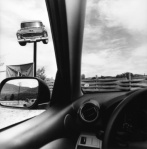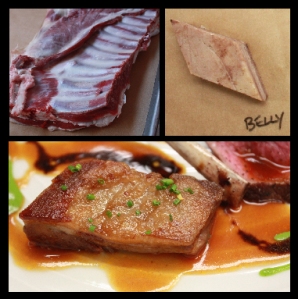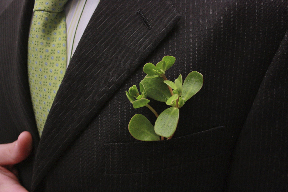(originally posted December 29, 2010) Considering the tragic, scary and downright stupid things which dominated the news this year, we thought we would end our last newsletter of 2010 with a Top Ten list that speaks to brilliance and talent, with one pertinent reminder that because nothing ever stays the same ~ the only direction that ultimately matters is forward.
 1. The Low Budget Film, alive and kicking
1. The Low Budget Film, alive and kicking
The Social Network had a great script, and Inside Job should be required viewing for every American, but the cinematic theme of the year wasn’t about greed and technology, rampant though they both are. Film is primarily a visual medium, so it was all the more remarkable that the most inspired films released this year focused on how, in spite or because of the proliferation of social media, language is failing us. Nicole Holofcener’s mordant, deeply funny Please Give was a pointed but gentle rebuke at the narcissistic face of liberal guilt. Luca Guadagnino’s I Am Love was a ravishing visual roman à clef that brought Visconti to mind, confirmed Tilda Swinton’s face as a force of nature, and for all the power in which it captured the empty language of the rich, could have been a silent picture. Of all our favorite films this year, however, none was more impressive than Debra Granik’s Winter's Bone. An explosion of brilliant new talent both in front of and behind the camera, it was the kind of low budget film about the human condition we used to think only foreigners could make. A mystery, an exploration of what it means to be poor and illiterate in America, and, most poignantly, a use of lost language as spare and wounding as a Faulknerian tone poem, this is a great American film. In drawing a world bereft of morality and faith, it speaks to what happens when human beings fall back on superstitions and tribal tradition to guide their destiny. Which, when you think about it, is a pretty powerful global message as well.
 2. Montaigne Rules
2. Montaigne Rules
Jonathan Franzen’s Freedom was the great American novel of the year, deserving of all the hype, but the most remarkable book this year, for being both a homecoming and a map to the future, was How to Live (or) A Life of Montaigne by Sarah Bakewell. An inventive biography about a dude who lived four hundred years ago, Bakewell invites us to re-discover a voice so honest, charming and clever its wisdom is as relevant today as any self-help book you are likely to find. I am an unapologetic member of the dying tribe that still believes the unexamined life is not worth living, but even if your definition of wisdom runs only to aphorism, you will find a lot to chew on here. Bakewell does an extraordinary job of letting Michel Eyquem de Montaigne speak for himself, while placing him firmly in a Renaissance tradition that exalted the life of the mind. This genteel nobleman was a winegrower who spoke fluent Latin, a self-taught philosopher who participated fully in politics and invented the short for essay which he used to reflect amusingly on every issue of the day. Montaigne believed the more thought we put into life, the more we get out of it. Amen to that.
 3. Park Here If You Must
3. Park Here If You Must
I’ve not yet been inside Herzog & de Meuron’s new parking & retail structure in Miami, 1111 Lincoln Road Garage, but I almost don’t need to. It's pretty damn hard to rethink space on any level in the current economic climate ~ when you work as big as these guys do it's practically impossible. Yet this Swiss firm consistently challenges preconceived notions of material, design and program in future-forward ways. While the current focus in architecture on ecological and ergonomic utility is certainly important, aesthetically, when it comes to public spaces that aren’t deep pocket museums, it’s been pretty much of a bust. As Healdsburg’s parking problems continue to grow, it’s refreshing to think there may be alternatives to addressing that problem without resorting to the concrete parking bunker. 1111 Lincoln has a mixed-use program with pop-up retail on the top floor. Its undulating concrete walls will eventually be grown to soften the ‘view’ of all that metal inside. During the recent Art Basel Miami Beach some of its vast floor space was also used for performance art, very cool indeed. Even for a town as small as ours I see the potential of parking cars, flea market sales, and stimulating performance art all in one place, especially when that art could represent a segment of the community that cannot afford high street rents.
 4. In Bed with Jon and Frank
4. In Bed with Jon and Frank
With the exception of my husband, I spent an inordinate amount of quality time in bed with these two men this year. Late at night, especially when it was a frustrating news day, I fell asleep with a smile on my face thanks to Jon Stewart, America's court jester, who says what we are all thinking a hell of a lot funnier than it plays in our aching heads. Frank Rich provided a different kind of salve for these trying times. In an age when facts have become almost beside the point on a increasingly partisan and commercialized media playing field, his thoroughly researched, riveting editorials in the New York Times every Sunday morning were David and Goliath efforts that never failed to speak truth to power.
 5. Public Speaking
5. Public Speaking
While Stewart and Rich deserve twin “the Emperor is Wearing No Clothes” awards this year, Martin Scorsese did us all a favor by bestowing a lifetime achievement nod on Fran Lebowitz, the closest thing America has to a wit the size of Oscar Wilde’s with the feminine acuity of Dorothy Parker. Public Speaking, which arrived on cable without much fanfare is a program that actually lives up to being Must See TV. An hour spent with this woman is an instant elixir, brief respite to the proliferation of Kim Kardasian types and all those other 'fame ho’s' (both male and female) that increasingly clutter the airwaves, and our lives. This is that rare hour of amusing enlightenment which sidesteps youth for age, fake beauty for character, stupidity for profundity. I was especially taken with her remarks about the audience that was lost with AIDS and how that has affected the arts, and the importance of elitism in culture (as opposed to building an elitist society) which has lead to a degradation of quality that has affected every aspect of American cultural life.
 6. Jamie at Home
6. Jamie at Home
One of the questions I asked myself in 2010 ~ that I didn’t get any closer to answering~ was why food programs on TV continue to get worse instead of better. With the proliferation of farmer's markets, the fervent interest in sourcing, the rise of urban farming, why does food programming increasingly reek of such dumbing down? I haven’t been a fan of the Food Network since they went over to the dark side dropping Mario for Paula. So I was thrilled to find Jamie Oliver over on the Cooking Channel (with fellow Brits Nigella Lawson and Two Fat Ladies) a few months back. I have no idea if he really lives on his farm with Jools and the kids, cooking in wood fired ovens using food he has grown, and I really don’t care. His visceral description of ingredients, the way he touches food, the simplicity of his ideas (recipes are almost besides the point for Jamie) are simply brilliant. I’ve loved Jamie since Naked Chef days. He is a lovely boy (as my dear friend Lynda would say) who has taken his fame as a serious opportunity to improve everything around him for as long as the dance lasts. Yes, his experience with getting Americans to eat healthier was a disaster, but this program is worth taping and referring back to. If you don’t get the channel, go online where you can download the recipes for free.
 7. Jil at Home
7. Jil at Home
Speaking of food that doesn’t have to be precious to be delicious, go figure that the best meal I had all year (not made by Chef Fancher) was a simple vegetable soup. Why vegetable soup when I had the great privilege to eat food from the kitchens of Mario, Jean-George, Daniel, April, David, Doug and Ari? You know the Paul Simon line ‘life is what happens when you’re busy making other plans?’ Sometimes it's true about great dishes as well. Food was the last thing on my mind when I started to think about dinner on November 2nd. The stupidity and vitriol in the run-up to the elections that day had, quite literally, made me sick to my stomach. As it was a Tuesday and the restaurant was closed, I rummaged through the walk-in and the fridges, then spent a long time foraging through the raised herb and vegetables beds behind the gallery. It must have taken three hours to make that soup. At first I was simply avoiding the results of the election, but slowly, as I sliced every vegetable carefully, adding them to the pot one at a time, patiently watching them turn translucent, bubble, and simmer I came to see that while the results were now out of my control, feeding myself, my family, and members of the human race who, by luck or by design, wander into Barndiva, wasn’t. In the end I didn’t make that soup so much as it made me. When I finally came to taste it I took great pride in the balance of sweet to salty, the rooty, herbal, heavenly smell, the glorious color. When Geoff tasted it later that night he looked up and said “this is really great, what’s in it?” “Hope”, I replied. He probably thought I was crazy, but there is nothing new in that.
 8. Cocktail of the Year
8. Cocktail of the Year
I don’t care if it sounds like nepotism, the best cocktails anywhere this year were served here at the barn. Strawberry Life called for the ripest of wild strawberries macerated into a cognac base to which we added a touch of Nagori Sake (cloudy, the result of unfiltered dormant yeast particles), homegrown Thai Basil and fresh lemon juice. Finished with a mist of Crème de Violette, it was summer in a glass which we should have called Sex in the Grass (no, not that grass Virginia). Ernest in Love, another favorite (ode to Hemingway’s first marriage) featured Tequila and Aperol with local watermelon compressed with lemongrass, lime juice, agave nectar and, as a grace note, a spray of fresh rosewater. Thanks in great part to Stefan’s mad genius and Adam and Sammy’s desire to push the limits, we infused spirits with all manner of fresh fruit, herb and spice drams, cold smoked apples and rosemary from our farm, washed brown butter, infused rare black teas, fabricated pumpkin curries and stone fruit jams, chopped through all manner of homegrown chili and exotic citrus until our eyes rolled. Croatian cherries? No problem. Jack Daniel's barrel woodchips? Torch ‘em. With the exception of the night Stefan almost burned down the barn cooking up some concoction, every drink these three guys put out this year was bloody brilliant. I was a very proud mama indeed (albeit one with an aching liver.) Cocktail of the year goes to The Lover (named after the great Marguerite Duras novella of the same name) because it perfectly balanced my favorite fruit (white peaches) with fresh ginger and the green herbal notes of lemon verbena we grew from a plant Bonnie Z gave us. Filtered sake and a hit of Navarro grape juice added sweet and yeasty notes. We finished the drink at the bar by igniting a poof of green chartreuse ~ this Divatini even had magic. The trick of making craft cocktails at this level is that all the flourishes must soften and meld the minute you pick up the glass to drink. These do. Cheers.
 9. Picture of the Year
9. Picture of the Year
Without a doubt you will find more globally important images if you click the links below, but the moment Lukka captured of the Healdsburg Post Office burning resonates deeply for us on several levels. It marks the end of an era: no more walking distractedly through town to post a letter and find the moment of the day in which the town reclaimed you. Sometimes it was just a wave from a neighbor, a quick coffee from Flying Goat, a simple breeze that made you look up at the trees in the Plaza. I am not alone in mourning the loss that experience will mean to living here. But in the weeks and months that followed the fire, as it became clear that efforts by Jim Wood, Ray Holly and others to re-build would come to naught, I began to understand that more than the post office was gone. What if the loss we were experiencing on a community level was just the beginning of the end to Snail Mail which will be gone soon, like listening to music on CD’s, watching films on DVD’s, conversing on land-line telephones. Some of these ‘advances’ are good, no doubt, and all of them will seem inevitable when we look back. What is hardest to reconcile is how change like this undermines a precious connection to the time and place, and to the people you accidentally get to know when you wandered out to experience life first hand.
New York Times 2010 year in pictures
 10. A Town Full of Babies
10. A Town Full of Babies
Losing the post office was sad, which makes the last item on our top ten list all the more important. 2010 was the Year of the Baby here in Healdsburg ~ everywhere you looked gorgeous babies glided by with their newly minted parents, making everyone in their wake feel like a cockeyed optimist. Some were spied repeatedly dining in our gardens or at Scopa, others were seen hiding in the foliage at Dragonfly, the changing rooms at Arboretum, the shampoo station at Brush. One young man we knew as a baby had his first, while our bookkeeper had her fifth. This proliferation of new life, the growth of families that have put roots down here and have already contributed so much ~ with so much more left to come ~ is something we can take joy in. And we do.



















































































































